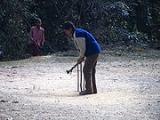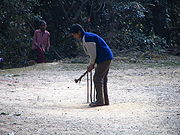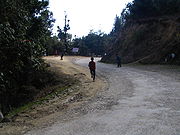
Street cricket
Encyclopedia
Street cricket or gali cricket is a stripped-down version of the international sport of cricket
, popular across the South Asia
and in other cricket-playing nations. In the countryside, dried lakes and river beds are often used as playgrounds for cricket. In cities, it is played in apartment corridors, apartment parking lots, parks etc. People typically play street cricket in narrow bylanes, streets, and ghettos. The size of the road or traffic does not hinder the progress of a game; children often wait for the traffic to clear before playing consecutive deliveries. Bandhs (strikes), when the main roads are devoid of traffic, provide an occasion for children to take over wide open spaces for a day. Chennai
is popularly known as the 'Street cricket capital of the world' or the 'One-pitch city', because when you travel to Chennai, you can see street cricket everywhere. The term 'One-pitch city' was coined by the cricket legend Kapil Dev
to express that all the street cricket players in Chennai consider one-pitch catch as a wicket.

 An interesting aspect of street cricket is the rules that apply while playing. These rules have been devised to cause the least public inconvenience while playing. Several innovative rules (e.g. Current, Half-crease, One-Man Gaaji, Last-Man Gaaji, Wait for the Crease, Full Cover, Fast Appeal, 2G(nothing to do with 2G spectrum scam
An interesting aspect of street cricket is the rules that apply while playing. These rules have been devised to cause the least public inconvenience while playing. Several innovative rules (e.g. Current, Half-crease, One-Man Gaaji, Last-Man Gaaji, Wait for the Crease, Full Cover, Fast Appeal, 2G(nothing to do with 2G spectrum scam
) are seen in Street Cricket, which make the game more interesting. While hitting a ball as far as you can in a cricket stadium is rewarded by runs, doing the same might shatter a few glass panes and thus put the future of the match in jeopardy. Hence batsmen with ultra aggressive instincts stand a very good chance of getting out very soon. Each venue carries its importance when the Wall-Catch rule comes into play. This game is also played in most school grounds during the breaks.
A very important rule that is almost always used in Street Cricket is "one pitch catch" or "pitch catch". This rule declares the batsman as out if a fielder catches the ball after it has pitched once after the batsman hits it. One pitch could mean bouncing off the ground/wall/tree etc. This rule typically puts the batsman at tremendous disadvantage/pressure. So, many times this rule is tweaked to "one pitch one hand". As can be guessed, this means that the fielder has to use only one hand in catching a ball after it has bounced once; if the fielder uses both hands to catch a ball after it has pitched once, then the batsman is declared not out. In Australian and English informal cricket, this rule is often known as "one hand, one bounce".
This is the normally used toss where one random player (the "captain", typically the tallest member of the team) flips a coin and the opponent team "captain" calls. The team which wins it almost always chooses to bat first irrespective of pitch conditions, team strength etc.
In Or Out:
The more innovative toss used when the team players have no coin to flip. A small piece of stone (dimension 5–10 mm diameter) is placed in the web between the thumb and the index finger. The team captain rotates his entire hand at a fast rate and finally asks the question, " In or Out". The opposing team captain has to guess whether the toss object (the same stone) is still in the hand or has been thrown out. If he guesses right he wins, otherwise he loses the toss. The best part of this toss is that the probability is always 0.5 since no human eye can track with certainty either the slipping of the tossed object or the presence of it between the fingers.
Flat or Dome:
Also known as 'Mountains or plains', one more in the series of innovative methods of toss, when the players have a bat which resembles a cricket bat (one with a flat side and the other with a slight dome), the toss is done the following way.
The bat is tossed in the air, the captains need to call whether the flat/the dome side of the bat is going to face upwards. Whoever calls it right wins the toss.
Even or Odd:
One of the alternative methods to universal coin toss. A random monetary bill (rupee or note) is drawn by one of the captains, the opponent calls for odd or even. The "even or odd" value is derived by adding the circulation seqence number. Whoever has the correct call is the winner.
Even or Odd (2):
One player from each side chooses a number typically by displaying it as number of fingers in his hand (thus number < 5) and shouting 'Even' or 'Odd'. Then the sum of the both the numbers is calculated and if the parity turns out to be the same as the call then the captain wins the toss and chooses to bat or field.
Colour or White:
Yet another innovative method, toss is done by picking up a stray paper from the street with a special requirement — one face is supposedly white or light colour and other coloured/dark coloured/written text. A small chit (approximate 5–10 mm) is torn and thrown upwards, immediately the call is made while the chit is precraiously wobbling down. The chit touch's the ground, its colour of the face facing upwards makes one of them as a winner. Beware of windy conditions and an open manhole etc.
Tip Top:
One random member from each team stand at a distance facing each other, one of the member takes a step ahead and calls "Tip" and then the member from the other team does the same and calls "Top". This process continues till one person oversteps the other (puts his foot upon the other person's), the team of whom the overstepping member belongs to wins the 'toss'.
Cricket
Cricket is a bat-and-ball game played between two teams of 11 players on an oval-shaped field, at the centre of which is a rectangular 22-yard long pitch. One team bats, trying to score as many runs as possible while the other team bowls and fields, trying to dismiss the batsmen and thus limit the...
, popular across the South Asia
South Asia
South Asia, also known as Southern Asia, is the southern region of the Asian continent, which comprises the sub-Himalayan countries and, for some authorities , also includes the adjoining countries to the west and the east...
and in other cricket-playing nations. In the countryside, dried lakes and river beds are often used as playgrounds for cricket. In cities, it is played in apartment corridors, apartment parking lots, parks etc. People typically play street cricket in narrow bylanes, streets, and ghettos. The size of the road or traffic does not hinder the progress of a game; children often wait for the traffic to clear before playing consecutive deliveries. Bandhs (strikes), when the main roads are devoid of traffic, provide an occasion for children to take over wide open spaces for a day. Chennai
Chennai
Chennai , formerly known as Madras or Madarasapatinam , is the capital city of the Indian state of Tamil Nadu, located on the Coromandel Coast off the Bay of Bengal. Chennai is the fourth most populous metropolitan area and the sixth most populous city in India...
is popularly known as the 'Street cricket capital of the world' or the 'One-pitch city', because when you travel to Chennai, you can see street cricket everywhere. The term 'One-pitch city' was coined by the cricket legend Kapil Dev
Kapil Dev
Kapil Dev Ramlal Nikhanj , better known as Kapil Dev, is a former Indian cricketer. He captained the Indian cricket team which won the 1983 Cricket World Cup...
to express that all the street cricket players in Chennai consider one-pitch catch as a wicket.
Rules
Tennis balls usually taped up with some insulation tape, specially made for cricket and slightly heavier than usual tennis balls are normally used. (Rubber balls are sometimes preferred because they are cheaper.) A dustbin, broom sticks or canes serve as stumps at the batsman's end while a piece of brick or a pipe serves as the stumps at the bowler's end. When sticks and canes are not readily available, two stones with a gap of around 10 inches are kept on the ground. The players then assume the stumps to be at an imaginary height (usually above the waist level of the batsman). This leads to many interesting events as to whether the ball would have hit the stumps or not had the stumps been there for real. Sometimes the stumps are drawn on the walls: the advantages being, there isn't a need for a wicket keeper and the ball doesn't run away even when the batsman misses.

2G spectrum scam
The 2G spectrum scandal involved officials in the government of India illegally undercharging mobile telephony companies for frequency allocation licenses, which they would use to create 2G subscriptions for cell phones...
) are seen in Street Cricket, which make the game more interesting. While hitting a ball as far as you can in a cricket stadium is rewarded by runs, doing the same might shatter a few glass panes and thus put the future of the match in jeopardy. Hence batsmen with ultra aggressive instincts stand a very good chance of getting out very soon. Each venue carries its importance when the Wall-Catch rule comes into play. This game is also played in most school grounds during the breaks.
A very important rule that is almost always used in Street Cricket is "one pitch catch" or "pitch catch". This rule declares the batsman as out if a fielder catches the ball after it has pitched once after the batsman hits it. One pitch could mean bouncing off the ground/wall/tree etc. This rule typically puts the batsman at tremendous disadvantage/pressure. So, many times this rule is tweaked to "one pitch one hand". As can be guessed, this means that the fielder has to use only one hand in catching a ball after it has bounced once; if the fielder uses both hands to catch a ball after it has pitched once, then the batsman is declared not out. In Australian and English informal cricket, this rule is often known as "one hand, one bounce".
Toss
Coin Toss:This is the normally used toss where one random player (the "captain", typically the tallest member of the team) flips a coin and the opponent team "captain" calls. The team which wins it almost always chooses to bat first irrespective of pitch conditions, team strength etc.
In Or Out:
The more innovative toss used when the team players have no coin to flip. A small piece of stone (dimension 5–10 mm diameter) is placed in the web between the thumb and the index finger. The team captain rotates his entire hand at a fast rate and finally asks the question, " In or Out". The opposing team captain has to guess whether the toss object (the same stone) is still in the hand or has been thrown out. If he guesses right he wins, otherwise he loses the toss. The best part of this toss is that the probability is always 0.5 since no human eye can track with certainty either the slipping of the tossed object or the presence of it between the fingers.
Flat or Dome:
Also known as 'Mountains or plains', one more in the series of innovative methods of toss, when the players have a bat which resembles a cricket bat (one with a flat side and the other with a slight dome), the toss is done the following way.
The bat is tossed in the air, the captains need to call whether the flat/the dome side of the bat is going to face upwards. Whoever calls it right wins the toss.
Even or Odd:
One of the alternative methods to universal coin toss. A random monetary bill (rupee or note) is drawn by one of the captains, the opponent calls for odd or even. The "even or odd" value is derived by adding the circulation seqence number. Whoever has the correct call is the winner.
Even or Odd (2):
One player from each side chooses a number typically by displaying it as number of fingers in his hand (thus number < 5) and shouting 'Even' or 'Odd'. Then the sum of the both the numbers is calculated and if the parity turns out to be the same as the call then the captain wins the toss and chooses to bat or field.
Colour or White:
Yet another innovative method, toss is done by picking up a stray paper from the street with a special requirement — one face is supposedly white or light colour and other coloured/dark coloured/written text. A small chit (approximate 5–10 mm) is torn and thrown upwards, immediately the call is made while the chit is precraiously wobbling down. The chit touch's the ground, its colour of the face facing upwards makes one of them as a winner. Beware of windy conditions and an open manhole etc.
Tip Top:
One random member from each team stand at a distance facing each other, one of the member takes a step ahead and calls "Tip" and then the member from the other team does the same and calls "Top". This process continues till one person oversteps the other (puts his foot upon the other person's), the team of whom the overstepping member belongs to wins the 'toss'.

